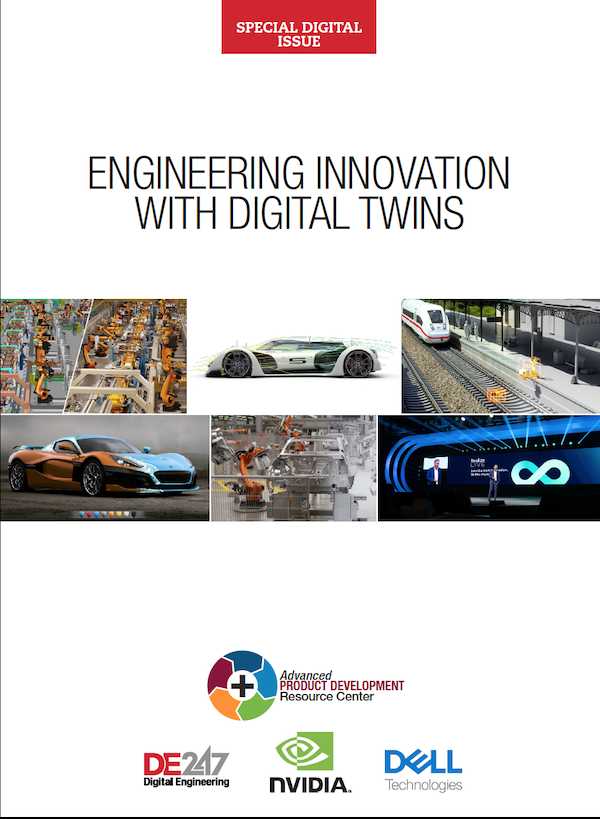NVIDIA Announces Digital Twin Platform for Scientific Computing
NVIDIA Modulus and Omniverse enable modeling physical phenomena for NVIDIA’s Earth-2 and Siemens Gamesa's wind farms.

Siemens Gamesa Renewable Energy is using the NVIDIA platform to use AI to accurately model the effects of turbine placement on wind farm performance. Image courtesy of NVIDIA.
Latest News
March 24, 2022
A new NVIDIA platform for scientific digital twins can accelerate physics machine-learning models to solve million-x scale science and engineering problems thousands of times faster than previously possible, the company announced at the GTC conference this week.
The accelerated digital twins platform for scientific computing consists of the NVIDIA Modulus AI framework for developing physics-ML neural network models, and the NVIDIA Omniverse 3D virtual world simulation platform.
According to the company, the platform can create interactive AI simulations in real time that are physics-informed to accurately reflect the real world, accelerating simulations such as computational fluid dynamics up to 10,000x faster than traditional methods for engineering simulation and design optimization workflows. It enables researchers to model complex systems, such as extreme weather events, with higher speed and accuracy when compared to previous AI models.
At GTC, the company provided two example applications of the technology. The NVIDIA FourCastNet physics-ML model emulates global weather patterns and predicts extreme weather events, such as hurricanes, up to 45,000x faster than traditional numerical prediction models, the company said. In addition, Siemens Gamesa Renewable Energy is using AI to optimize wind turbine design.
“Accelerated computing with AI at data center scale has the potential to deliver millionfold increases in performance to tackle challenges, such as mitigating climate change, discovering drugs and finding new sources of renewable energy,” said Ian Buck, vice president of Accelerated Computing at NVIDIA. “NVIDIA’s AI-enabled framework for scientific digital twins equips researchers to pursue solutions to these massive problems.”
NVIDIA Modulus takes both data and the governing physics into account to train a neural network that creates an AI surrogate model for digital twins. The surrogate can then infer new system behavior in real time, enabling dynamic and iterative workflows. Integration with Omniverse brings visualization and real-time interactive exploration, according to NVIDIA.
NVIDIA Omniverse is a real-time virtual world simulation and 3D design collaboration platform. It enables the real-time visualization and interactive exploration of digital twins using the output surrogate model from Modulus.
Fourier neural operators and transformers enable the NVIDIA FourCastNet physics-ML model, trained on 10TB of Earth system data. As a step toward Earth-2 – the system announced by NVIDIA CEO Jensen Huang to create a digital twin of Earth in Omniverse – FourCastNet emulates and predicts the behavior and risks of extreme weather events such as hurricanes and atmospheric rivers with greater confidence and up to 45,000x faster.
The digital twins platform is is being leveraged for simulation research for the layout of wind farms equipped with Siemens Gamesa Renewable Energy wind turbines, making it possible to use AI to accurately model the effects of turbine placement on their performance in a wide variety of weather scenarios. This is expected to lead to optimized wind park layouts capable of producing up to 20% more power than previous designs.
“The collaboration between Siemens Gamesa and NVIDIA has meant a great step forward in accelerating both the computational speed and the deployment speed of our latest algorithms development in such a complex field as computational fluid dynamics, and set the foundations for a strong partnership in the future,” said Sergio Dominguez, onshore digital portfolio manager at Siemens Gamesa.
To learn more about NVIDIA’s digital twins platform for scientific computing, watch the GTC 2022 keynote from Jensen Huang. Register for GTC for free to attend sessions with NVIDIA and industry leaders.
More NVIDIA Coverage
Subscribe to our FREE magazine, FREE email newsletters or both!
Latest News
About the Author
DE’s editors contribute news and new product announcements to Digital Engineering.
Press releases may be sent to them via [email protected].






